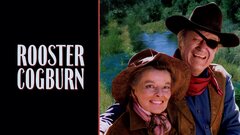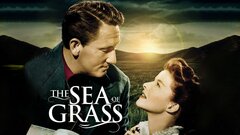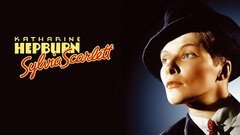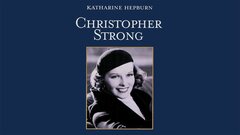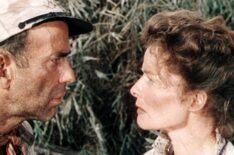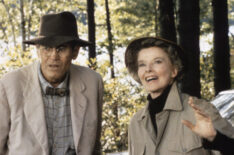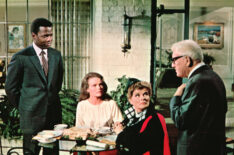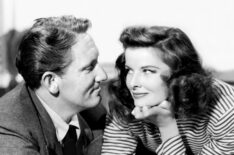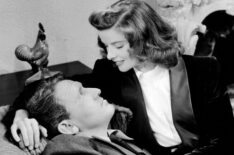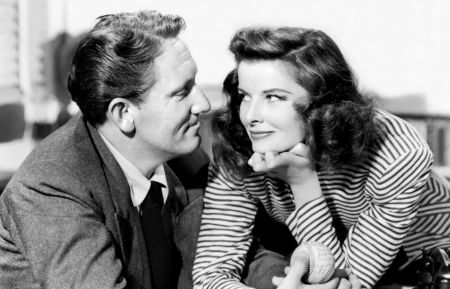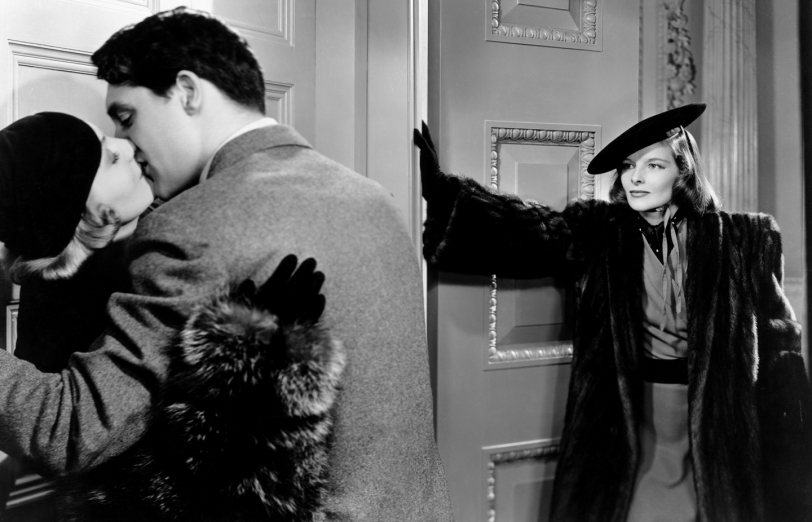A true iconoclast known for her intelligence, determination and fierce demeanor Katharine Hepburn demonstrated remarkable staying power in a screen career that spanned more than six decades, winning three of her four Best Actress Oscars after the age of 60. An overnight sensation upon winning her first Academy Award for "Morning Glory" (1933), the headstrong actress soon chafed under the constraints of the male-dominated studio system.
Brash and outspoken - she was one of the first American female celebrities to wear trousers - her prickly public image and a series of poor project choices earned her a reputation as "box office poison" until "The Philadelphia Story" (1940) allowed her to take control over her career as few actresses had before. From then on, Hepburn carefully cultivated roles that were largely reflections of her own unique persona. She perfected the battle-of-the-sexes comedy formula with the love of her life, Spencer Tracy, in such films as "Woman of the Year" (1942) and "Adam's Rib" (1949), then entered a second phase of her career with the prim "spinster" roles first seen in "The African Queen" (1951).
For many, these iconic performances would eventually outshine her earlier triumphs. Hepburn's final film with Tracy in "Guess Who's Coming to Dinner" (1967) won her another Oscar, as did her pairing with Peter O'Toole in "The Lion in Winter" (1968) and Henry Fonda in "On Golden Pond" (1981). An unrepentantly private person, Hepburn maintained a reclusive, yet deeply satisfying life up until her passing at the age of 96.
Katharine Houghton Hepburn was born in Hartford, CT on May 12, 1907 to Katharine Houghton and Dr. Thomas Norval Hepburn. Progressive, well-educated members of the social elite, her parents' individuality and strong opinions greatly shaped the young Hepburn and her five siblings. Her mother was a suffragist who advocated birth control, while her surgeon father was an outspoken educator on the realities and dangers of venereal disease.
She was a bona fide tomboy from an early age - even referring to herself as "Jimmy" at one point - wearing her hair short, and excelling at such physical activities as tennis, swimming and golf. Hepburn's idyllic life was shaken to its core when, at age 14, she discovered the body of her beloved older brother, Thomas, hanging from a rafter while visiting at the home of a family friend in New York. While her family refused to acknowledge the death as a suicide - they awkwardly insisted that it must have been some experiment or magic trick gone wrong - Hepburn was noticeably altered by the traumatic experience.
The once outgoing and precocious teenager suddenly became withdrawn and sullen, so much so that she was eventually removed from the prestigious Oxford School and tutored privately at home. Having been away from the social dynamic of school for several years by the time she entered Bryn Mawr College, Hepburn's first semesters at the university proved difficult, as attested by her low grades.
It was the theater and a newly discovered love of acting that brought Hepburn out of her shell. Needing a satisfactory GPA to participate in the college's drama program, she increased her academic efforts in order to land roles in such university productions as "The Woman in the Moon." After graduating from Bryn Mawr in 1928, Hepburn embarked on a stage career, making her professional debut as a lady-in-waiting in a Baltimore stock production of "The Czarina."
Despite making her Broadway debut in 1928's short-lived "These Days," the young actress' first professional experiences were punctuated by negative reviews and even outright dismissals. While briefly considering an early retirement from the stage, she married wealthy Pennsylvanian businessman Ludlow Ogden Smith that same year. Later, she would admit with a profound sense of regret that the marriage had been an impulsive act of convenience, and that it was unfair to Smith, who appeared to love her deeply.
The stage still called to her, however, and soon Hepburn was back to work with stock theater companies in Massachusetts and Connecticut. Her relationships with directors and her fellow actors continued to be rocky until she landed a role seemingly tailor-made for her unique attitudes and attributes. Cast as the Greek heroine Antiope in "The Warrior's Husband" (1932), an updating of "Lysistrata," Hepburn made her return to Broadway with an entrance that called for her to leap onto the stage with a stag slung across her athletic shoulders. Both the show and Hepburn received strong notices, and before long Hollywood came calling.
Hepburn made her feature film debut in director George Cukor's marital melodrama "A Bill of Divorcement" (1932) opposite no less than John Barrymore. The film was a commercial success and Hepburn's critically-lauded performance made her a star virtually overnight. Newly signed to a contract with RKO Studios, she went on to appear in the less successful "Christopher Strong" (1933), followed by a starring role opposite Douglas Fairbanks, Jr. in the romantic-drama "Morning Glory" (1933).
Hepburn's compelling turn as an aspiring actress in only her third film won the 25-year-old her first Academy Award for Best Actress. In a move typical of Hepburn, she did not attend the ceremony to receive the statuette - a snub she would repeat three more times during her historic career. She reteamed with Cukor - who would become a life-long friend - for an adaptation of Louisa May Alcott's "Little Women" (1933), which went on to become a massive success and was later regarded by Hepburn as one of the finest performances she would ever commit to film.
Having achieved the stardom she so desperately sought, Hepburn callously divorced "Luddy" Smith in 1934, and although she later freely admitted to treating him horridly during their time together, the two remained close friends throughout the remainder of his life.
Hepburn's sudden rise to stardom experienced a just as swift, drastic change in trajectory after the release of "Spitfire" (1934), in which she was terribly miscast as an Ozark mountain hillbilly. The film was a commercial flop. The actress' humiliation was only exacerbated when her return to Broadway later that year in "The Lake" opened to disastrous critical reviews, with her performance inspiring the famous Dorothy Parker quip, "Miss Hepburn runs the gamut of emotions from A to B."
After two more feature films sank at the box-office, Hepburn earned a modicum of redemption for her Oscar-nominated turn as a social climber in the hit romance "Alice Adams" (1935), her first of three films with George Stevens. Her next film, Cukor's "Sylvia Scarlett" (1936), in which Hepburn disguises herself as a boy throughout most of the movie, was most notable as an early example of Hepburn's then-controversial androgynous fashion sense, in addition to being her first onscreen pairing with leading man Cary Grant.
Nevertheless, it performed dismally at theaters and was dismissed by critics, as were her next three pictures. It seemed as if the overnight sensation was on her way to becoming a Hollywood has-been after only five years in the business.
Unfortunately, Hepburn's admirable work alongside a strong ensemble cast in Gregory La Cava's "Stage Door" (1937) did little to break the trend. Neither did her reteaming with Grant for director Howard Hawks' screwball romantic-comedy "Bringing Up Baby" (1938), which although a commercial failure at the time of its release was later considered a masterpiece of the genre. Now on the Independent Theater Owners Association's "box office poison" list and being offered B-movies by her studio, the financially enabled Hepburn bought her way out of her contract with RKO.
She then took her talents to Columbia Pictures, where she continued to fine-tune her chemistry with Grant in the Cukor-directed comedy "Holiday" (1938), based on a play by Phillip Barry for which she had served as an understudy a decade earlier. Despite strong critical notices for her work with Grant - one of Hollywood's biggest leading men at the time - it too, was a flop. In a move unprecedented at the time, the actress took her career firmly into her own hands when she agreed to appear in Barry's latest play "The Philadelphia Story," in addition to securing its film rights with the assistance of millionaire Howard Hughes, her lover at the time. When the production became a sensation on Broadway, every major studio came to Hepburn with offers to film it.
Strong-willed and crafty, she secured a deal with MGM that allowed her to not only star in the film, but choose its director and her co-stars, as well. Directed by Cukor and featuring Grant and Jimmy Stewart, "The Philadelphia Story" (1940) was one of the most successful movies of the year. Her delightful performance as spoiled socialite Tracy Lord all but erased the "box office poison" stigma that had plagued her just two years prior.
With her career literally saved by "The Philadelphia Story," Hepburn collaborated with playwright Barry once again for the romantic-drama "Without Love" on Broadway in 1942 with a role written specifically for her. She was paired with respected actor Spencer Tracy for the first time in George Stevens' "Woman of the Year" (1942). The film with Tracy soon sparked what would be the most significant, meaningful romantic relationship Hepburn would ever have. "Woman of the Year" was another success at theaters and prompted several reviewers to comment on the palpable onscreen chemistry of its co-stars.
She reteamed with Cukor and Tracy for the dark mystery "Keeper of the Flame" (1942) and then again in an adaptation of Barry's wartime romantic-drama "Without Love" (1945). While neither effort featured any of the comedy and easy banter so prevalent in "Woman of the Year," and both met with a tepid reception from the critics, the Tracy-Hepburn combination proved to be a favorite with movie fans who flocked to buy tickets. By now, Hepburn had entered into a romantic relationship with the married Tracy, a troubled artist who battled alcoholism and Irish-Catholic guilt when it came to his failed marriage.
For her part, Hepburn committed herself to the man, even scaling back her professional endeavors in order to be by his side as much as possible. The majority of Hepburn's film output throughout the 1940s was alongside Tracy, and she often credited him for her strong box office standing over those years.
The second half of the decade included the noir "Undercurrent" (1946), another teaming with Tracy in the American West drama "The Sea of Grass" (1947) and the classical music biopic "Song of Love" (1947). In what was becoming a trend, her pictures with Tracy tended to perform better than those without. Also at the time, her open criticism of the communist witch-hunts in Washington, D.C. had generated a not insubstantial amount of backlash from the movie-going public and threatened to hurt her draw at theaters.
Once again, she rebounded with Tracy in director Frank Capra's political drama "State of the Union" (1948) and the "battle of the sexes" comedy "Adam's Rib" (1949), with the latter film considered by many to be the perfect pairing of the duo. At an age when most actresses began to contemplate a gradual retreat from the spotlight, Hepburn underwent a sort of second-phase renaissance in her career. In 1950, she returned to Broadway and tackled Shakespeare for the first time by playing Rosalind, the headstrong, cross-dressing heroine in "As You Like It."
The actress then pushed herself even further for her role as the prim missionary Rose Sayer in director John Huston's "The African Queen" (1951), co-starring Humphrey Bogart. While filming on location in the Congo, Hepburn became seriously ill with dysentery, and the harrowing ordeal of the film's production later became the subject of a memoir. It also became a massive box office hit, earned her yet another Oscar nomination, and proved that she could still have success without Tracy. Most importantly, Rose Sayer marked the first of a series of acclaimed roles that cast Hepburn as an eccentric, independent and strong-willed "spinster."
The success of "African Queen," however, did not mean the end of her roles as a romantic foil to Tracy. Written specifically for the pair, "Pat and Mike" (1952) gave Hepburn the opportunity to exhibit her natural athleticism as a talented sportswoman who, despite the odds, finds herself attracted to a rough-around-the-edges sports promoter (Tracy). Another hit for the star duo, it proved to be one of Hepburn's favorite onscreen appearances with Tracy. With renewed focus on her stage work, she traveled to London's West End for a 1952 mounting of George Bernard Shaw's "The Millionairess," before bringing the production to Broadway later that same year.
In one of the deeper professional regrets of her life, Hepburn attempted without success to film and star in an adaptation of the production. The disappointment was assuaged somewhat by her continued exploration of Shakespeare on stage in Stratford, Connecticut and on tour throughout the 1950s in productions of The Merchant of Venice," "Much Ado About Nothing," "Twelfth Night" and "Anthony and Cleopatra" and others. She also added more acclaimed "spinster" roles to her résumé with starring turns in director David Lean's European romance "Summertime" (1955) and opposite Burt Lancaster in "The Rainmaker" (1956). The following year she combined her now familiar spinster character with her earlier headstrong leading lady persona for the romantic-comedy "Desk Set" (1957), once again opposite Tracy.
Hepburn gave the "old maid" role a malevolent twist as the conniving Aunt Violet in the big screen adaptation of Tennessee Williams' southern gothic "Suddenly, Last Summer" (1959). Co-starring Elizabeth Taylor and Montgomery Clift, the film earned Hepburn strong notices, although by all accounts, she found working with director Joseph L. Mankiewicz to be a frustrating experience. After a three-year break from filmmaking, she returned with one of the finest performances of her career as the drug-addicted Mary Tyrone in director Sidney Lumet's memorable screen version of Eugene O'Neill's semi-autobiographical "Long Day's Journey Into Night (1962).
It would be several more years before Hepburn returned to screens, however, as she spent the ensuing five years caring for the love of her life, Tracy, whose health had rapidly declined, partially as a result of diabetes worsened by his continued alcoholism. While it was true that Tracy never considered divorcing his estranged wife, he and Hepburn were deeply in love, and her devotion to the actor knew no bounds. Fully aware that they were running out of time, the onscreen couple performed their cinematic swan song in director Stanley Kramer's interracial drama, "Guess Who's Coming to Dinner" (1967), co-starring Sidney Poitier and Hepburn's own niece, Katharine Houghton.
As Tracy delivers a short speech on the nature of enduring love near the end of the film, Hepburn can be seen visibly weeping in the background. This was no mere performance, as the actress was moved to actual tears, knowing full well how near the end her beloved "Spence" truly was. Spencer Tracy died a scant 17 days after "Guess Who's Coming to Dinner" had completed production. Tracy was posthumously nominated for an Oscar, while Hepburn won her second Academy Award as Best Actress for her performance. Stating that the memories would be too painful to relive, Hepburn claimed to have never watched the completed film.
Not surprisingly, the grieving Hepburn turned to work for strength and solace, taking on the role of Eleanor of Aquitaine opposite Peter O'Toole in "The Lion in Winter" (1968). The role earned the 61-year-old actress her third Best Actress Oscar. Less revered was her turn as "The Madwoman of Chaillot" (1969), a performance criticized as misguided by reviewers and ignored by audiences. Still eager to take risks, Hepburn - never known for her singing ability - appeared in her first and only Broadway musical, "Coco" in late 1969.
Although the show, which ran for nearly a year, garnered only mediocre reviews, praise for the actress' gutsy performance of the iconoclastic designer Coco Chanel was nearly universal. After a pair of minor feature film efforts, the star of stage and screen made her first forays into the medium of television with the movies "The Glass Menagerie" (ABC, 1973) and "Love Among the Ruins" (ABC, 1975). Both were Nielsen winners and the latter production, co-starring Laurence Olivier, earned Hepburn her only Emmy Award.
In a bit of stunt casting, Universal Pictures hoped an amalgam of "The African Queen" and "True Grit" (1969) would yield another hit film with "Rooster Cogburn" (1975). Co-starring John Wayne, the "True Grit" sequel was only moderately successful in comparison to its revered cinematic forbearers.
Over the next three years Hepburn performed on Broadway again in a well-received production of the comedy "A Matter of Gravity," filmed one of her biggest box-office failures with the family adventure "Olly Olly Oxen Free" (1978) and enjoyed one last collaboration with Cukor on the TV movie "The Corn Is Green" (CBS, 1979). Two years later, she was once again paired with a legendary leading man for the nostalgic family drama "On Golden Pond" (1981). Her inspiring performance as Ethel Thayer, the devoted, energetic wife of an aging professor suffering from memory loss (Henry Fonda) earned the actress a record-setting fourth Academy Award.
She appeared for the last time on Broadway later that year and into the next as the star of "The West Side Waltz." Her final starring role in a feature film was "Grace Quigley" (1984), a dark comedy about an elderly woman (Hepburn) who instead of waiting to die of old age, hires a young hit man (Nick Nolte) to kill her. The film, the polar-opposite of "Golden Pond," may have sunk like a stone at theaters, but Hepburn never regretted taking the role.
The octogenarian continued to work intermittently throughout the 1980s and 1990s in the made-for-television films "Mrs. Delafield Wants to Marry" (CBS, 1986), "Laura Lansing Slept Here" (NBC, 1988) and "The Man Upstairs" (CBS, 1992).
With Tracy and the majority of her Hollywood contemporaries now gone, Hepburn addressed many of the mysteries and misconceptions surrounding her astonishing life and career in the extraordinarily candid documentary "Katharine Hepburn: All About Me" (TNT, 1993). After a television turn opposite Anthony Quinn in "This Can't Be Love" (CBS, 1994), she returned



















